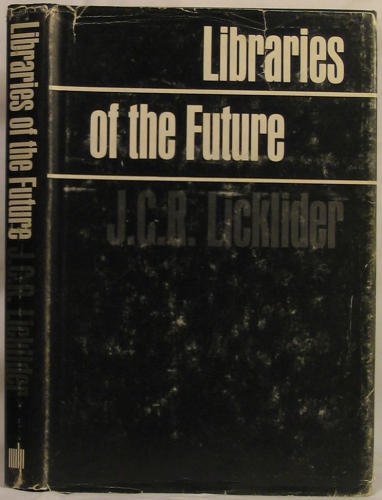J. C. R. Licklider: Libraries of the Future (1965)
Filed under book | Tags: · computing, knowledge, library, memory, technology

In this book J. C. R. Licklider discussed how information could be stored and retrieved electronically. Although he had not read Vannevar Bush’s “As We May Think,” he realized that Bush’s ideas had been diffused through the computing community enough to have provided a base for his own ideas. His theoretical information network, which he called a “procognitive system” sounds remarkably similar to Tim Berners-Lee’s World Wide Web: “the concept of a ‘desk’ may have changed from passive to active: a desk may be primarily a display-and-control station in a telecommunication-telecomputation system-and its most vital part may be the cable (‘umbilical cord’) that connects it, via a wall socket, into the procognitive utility net”. This system could be used to connect the user to “everyday business, industrial, government, and professional information, and perhaps, also to news, entertainment, and education.” (source)
Based on a study sponsored by the Council on Library Resources, Inc., and conducted by Bolt, Beranek, and Newman, Inc., between November 1961 and November 1963.
Publisher MIT Press, 1965
ISBN 026212016X, 9780262120166
219 pages
via Archive.org (where it is not available anymore)
Thomas Streeter: The Net Effect: Romanticism, Capitalism, and the Internet (2011)
Filed under book | Tags: · arpanet, capitalism, computing, history of computing, history of technology, internet, neoliberalism, technology

This book about America’s romance with computer communication looks at the internet, not as harbinger of the future or the next big thing, but as an expression of the times. Streeter demonstrates that our ideas about what connected computers are for have been in constant flux since their invention. In the 1950s they were imagined as the means for fighting nuclear wars, in the 1960s as systems for bringing mathematical certainty to the messy complexity of social life, in the 1970s as countercultural playgrounds, in the 1980s as an icon for what’s good about free markets, in the 1990s as a new frontier to be conquered and, by the late 1990s, as the transcendence of markets in an anarchist open source utopia.
The Net Effect teases out how culture has influenced the construction of the internet and how the structure of the internet has played a role in cultures of social and political thought. It argues that the internet’s real and imagined anarchic qualities are not a product of the technology alone, but of the historical peculiarities of how it emerged and was embraced. Finding several different traditions at work in the development of the internet—most uniquely, romanticism—Streeter demonstrates how the creation of technology is shot through with profoundly cultural forces—with the deep weight of the remembered past, and the pressures of shared passions made articulate.
Outstanding Academic Title from 2011 by Choice Magazine.
Publisher NYU Press, 2011
Critical Cultural Communication series
ISBN 0814741169, 9780814741160
221 pages
review (Yuenmei Wong, International Journal of Communication)
Comment (0)Theory, Culture & Society 29(4-5): Topologies of Culture (2012)
Filed under journal | Tags: · cultural theory, culture, database, mapping, media infrastructure, social theory, technology, topology

“In social and cultural theory, topology has been used to articulate changes in structures and spaces of power. In this introduction, we argue that culture itself is becoming topological. In particular, this ‘becoming topological’ can be identified in the significance of a new order of spatio-temporal continuity for forms of economic, political and cultural life today. This ordering emerges, sometimes without explicit coordination, in practices of sorting, naming, numbering, comparing, listing, and calculating. We show that the effect of these practices is both to introduce new continuities into a discontinuous world by establishing equivalences or similitudes, and to make and mark discontinuities through repeated contrasts. In this multiplication of relations, topological change is established as being constant, normal and immanent, rather than being an exceptional form, which is externally produced; that is, forms of economic, political and cultural life are identified and made legible in terms of their capacities for continuous change. Outlining the contributions to this Special Issue, the introduction discusses the meaning of topological culture and provides an analytic framework through which to understand its implications.” (from the Abstract)
With contributions by Celia Lury, Luciana Parisi, and Tiziana Terranova, Peter Sloterdijk, Rob Shields, Sandro Mezzadra and Brett Neilson, Penelope Harvey, Mike Michael and Marsha Rosengarten, Evelyn Ruppert, Steven D. Brown, Luciana Parisi, Richard Rogers, Xin Wei Sha, Brian Rotman, Scott Lash, Noortje Marres, Matthew Fuller and Andrew Goffey, Julian Henriques.
Publisher Sage
ISSN 0263-2764
342 pages
PDF (6 MB, updated on 2016-12-12)
Comment (1)
